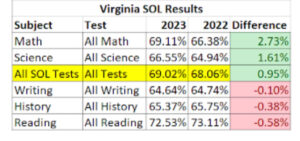 by Matt HurtVirginia Standards of Learning test results remained rather flat from 2022 to 2023 (see Table 1). This occurred despite the fact that many considered the pandemic over. There were many contributing factors, such as (but certainly not limited to) worsening teacher shortages and continued high rates of chronic absenteeism. However, among Virginia’s one hundred and thirty-one public school divisions, there were certainly some success stories.Table 1: Virginia SOL Results for 2022 and 2023
by Matt HurtVirginia Standards of Learning test results remained rather flat from 2022 to 2023 (see Table 1). This occurred despite the fact that many considered the pandemic over. There were many contributing factors, such as (but certainly not limited to) worsening teacher shortages and continued high rates of chronic absenteeism. However, among Virginia’s one hundred and thirty-one public school divisions, there were certainly some success stories.Table 1: Virginia SOL Results for 2022 and 2023 Among Virginia’s public school divisions from 2022 to 2023, overall SOL pass rate differences ranged from 8.94% to -9.19%. Oftentimes it is also useful to compare division rankings from one year to the next as relative measures of performance tend to control for a number of factors. The division that earned the greatest pass rate rank increase surpassed the performance of thirty-seven other divisions in 2023, while the division with the greatest decrease declined forty-four positions.Table 2 displays the top five divisions that realized the greatest gains in both SOL pass rates and SOL pass rate ranking in the state from 2022 to 2023. All of these divisions except for Greensville County are in the CIP consortium. Therefore, this article will focus primarily on the common themes that were identified in the success stories of Galax City, Smyth County, Charlotte County, and Page County.Table 2: Top SOL Pass Rate Improvement Divisions from 2022 and 2023
Among Virginia’s public school divisions from 2022 to 2023, overall SOL pass rate differences ranged from 8.94% to -9.19%. Oftentimes it is also useful to compare division rankings from one year to the next as relative measures of performance tend to control for a number of factors. The division that earned the greatest pass rate rank increase surpassed the performance of thirty-seven other divisions in 2023, while the division with the greatest decrease declined forty-four positions.Table 2 displays the top five divisions that realized the greatest gains in both SOL pass rates and SOL pass rate ranking in the state from 2022 to 2023. All of these divisions except for Greensville County are in the CIP consortium. Therefore, this article will focus primarily on the common themes that were identified in the success stories of Galax City, Smyth County, Charlotte County, and Page County.Table 2: Top SOL Pass Rate Improvement Divisions from 2022 and 2023 Keep the Main Thing the Main Thing!In each of these divisions, the top priority was the improvement of student outcomes as measured by SOL test results. This priority drove nearly every decision including distribution of resources, whether or not to implement new initiatives, and personnel decisions. In every teacher or administrator meeting that was conducted, this topic was kept at the forefront.While it may seem that this focus is ubiquitous in schools across the Commonwealth, it is not. There are many competing priorities in public schools coming from many different directions, many of which do not positively impact student outcomes. For example, in recent years topics such as transgender issues and certain books in schools have certainly diverted focus from the main objective. It is common knowledge that organizations can do one or two things very well, or many things less well.Data DrivenSince student outcomes are the key priority, student data drives the efforts of these divisions from the central office down to each classroom. Schools and teachers are identified for additional support based on student outcomes, and resources are allocated accordingly. Division comprehensive plans are written around student outcomes, and these outcomes are tracked throughout the year as well as from year to year to ensure progress is being made. Division and school leaders reach out to other more successful peers to learn what they’re doing that helps their kids so they can apply these lessons in their own schools and divisions. Teachers track student performance throughout the year and apply interventions immediately when students demonstrate the need. Groups of teachers review their data collectively in PLCs (professional learning communities) to learn from each other what is working and what is not.ExpectationsNearly every educator in Virginia would tell you that they have high expectations if given the choice among high, medium, and low expectations. However, it is not reasonable to believe that all of our expectations are the same. Conventional wisdom holds that those who expect more get more, and those who expect less get less. This is also true in public education. It has been demonstrated through the relationship of student grades and SOL proficiencies that expectations matter. Expectations matter a lot.The leaders and teachers of the divisions discussed in this article have increased their expectations, which helped to produce their outcomes last year. Their expectations are measurable and are aligned with improved student SOL outcomes. These expectations are conveyed through a variety of means, including the analysis of student final grades and SOL proficiencies, writing SOL pass rates into teacher and administrator evaluation goals, as well as cultivating cultures of high expectations that are a basis of the school community.Support: People Not ProgramsThe leaders in these four divisions realize that their conduit to success is their students, teachers, and parents. Rather than implementing programs, they invest time and attention in their people and make sure the needs of their people are met. The administrators and teachers truly exhibit servant leadership. For example, not all students come to school with pencils for a variety of reasons. Rather than fussing at the student, they simply provide the student a pencil. Not all teachers come fresh out of college with the expertise to ensure the success of their students. Administrators in these divisions spend the school day helping teachers and spend their evenings and weekends doing their administrative work.In conclusion, improvements in student outcomes, as demonstrated above. do not simply happen by chance. The educators in these divisions believe that their students can be successful, and they believe it is their duty to ensure that success. Through laser-like focus, reliance on data, maintaining high expectations, and supporting their people, they made it happen. Matt Hurt is director of the Comprehensive Instructional Program.
Keep the Main Thing the Main Thing!In each of these divisions, the top priority was the improvement of student outcomes as measured by SOL test results. This priority drove nearly every decision including distribution of resources, whether or not to implement new initiatives, and personnel decisions. In every teacher or administrator meeting that was conducted, this topic was kept at the forefront.While it may seem that this focus is ubiquitous in schools across the Commonwealth, it is not. There are many competing priorities in public schools coming from many different directions, many of which do not positively impact student outcomes. For example, in recent years topics such as transgender issues and certain books in schools have certainly diverted focus from the main objective. It is common knowledge that organizations can do one or two things very well, or many things less well.Data DrivenSince student outcomes are the key priority, student data drives the efforts of these divisions from the central office down to each classroom. Schools and teachers are identified for additional support based on student outcomes, and resources are allocated accordingly. Division comprehensive plans are written around student outcomes, and these outcomes are tracked throughout the year as well as from year to year to ensure progress is being made. Division and school leaders reach out to other more successful peers to learn what they’re doing that helps their kids so they can apply these lessons in their own schools and divisions. Teachers track student performance throughout the year and apply interventions immediately when students demonstrate the need. Groups of teachers review their data collectively in PLCs (professional learning communities) to learn from each other what is working and what is not.ExpectationsNearly every educator in Virginia would tell you that they have high expectations if given the choice among high, medium, and low expectations. However, it is not reasonable to believe that all of our expectations are the same. Conventional wisdom holds that those who expect more get more, and those who expect less get less. This is also true in public education. It has been demonstrated through the relationship of student grades and SOL proficiencies that expectations matter. Expectations matter a lot.The leaders and teachers of the divisions discussed in this article have increased their expectations, which helped to produce their outcomes last year. Their expectations are measurable and are aligned with improved student SOL outcomes. These expectations are conveyed through a variety of means, including the analysis of student final grades and SOL proficiencies, writing SOL pass rates into teacher and administrator evaluation goals, as well as cultivating cultures of high expectations that are a basis of the school community.Support: People Not ProgramsThe leaders in these four divisions realize that their conduit to success is their students, teachers, and parents. Rather than implementing programs, they invest time and attention in their people and make sure the needs of their people are met. The administrators and teachers truly exhibit servant leadership. For example, not all students come to school with pencils for a variety of reasons. Rather than fussing at the student, they simply provide the student a pencil. Not all teachers come fresh out of college with the expertise to ensure the success of their students. Administrators in these divisions spend the school day helping teachers and spend their evenings and weekends doing their administrative work.In conclusion, improvements in student outcomes, as demonstrated above. do not simply happen by chance. The educators in these divisions believe that their students can be successful, and they believe it is their duty to ensure that success. Through laser-like focus, reliance on data, maintaining high expectations, and supporting their people, they made it happen. Matt Hurt is director of the Comprehensive Instructional Program.
Tales of Student Success in 2023
Share this article
ADVERTISEMENT
(comments below)
ADVERTISEMENT
(comments below)
Comments
7 responses to “Tales of Student Success in 2023”
-
Maybe the silver lining here is the increase in child miners needed for EV manufacturing
-
Another brilliant statement of the obvious from Matt, but necessary given the education establishment’s too-common resistance to adoption of the obvious…
-
Glad to see you’re back! At some point, I’d love to better understand how a system like Henrico has some of the best schools in Va as well as many of the worst. Is it as simple as those poorly performing schools adoption CIP?
-
Through laser-like focus, reliance on data, maintaining high expectations, and supporting their people, they made it happen.”
That’s a recipe for success in many endeavors. Good to see it in some of our school systems.
-
Encouraging news. Solutions in plain sight and most school boards ignore them. Page County delivered improvements on a slim $10,000 per pupil expenditure.
I have to wonder, 20 billion bucks spent on public education in Virginia in 2021. Way more than ever now. And all we are getting is flat results plus chronic absenteeism? Way past time to tie the education dollars to the student/family and not the local school board.
https://uploads.disquscdn.com/images/c6016cbd8b1798daf30ca315517a67ba8dd89718aacd83c98dfc82236cb98450.jpg -
Why has the kid in the article’s picture switched from multiplying by 6s to multiplying by 7s?
What manner of dark arts are being practiced here?
-
Good Catch!
-

Leave a Reply
You must be logged in to post a comment.